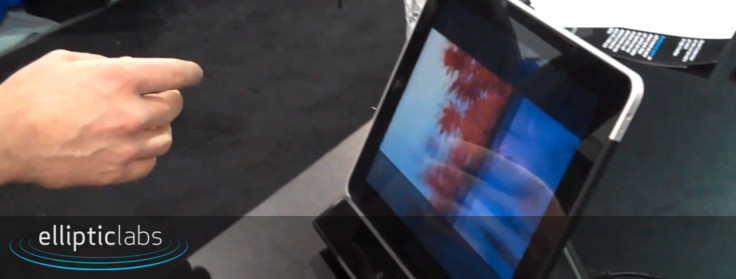Phones, Tablets To Get Touchless Gesture Technology By 2014

If you saw the 2002 flick “Minority Report,” chances are you thought about how cool it would be to control your computer with hand gestures like Tom Cruise’s character. Well, the next generation of Apple and Samsung devices may bring your dreams closer to reality. Norway's Elliptic Labs says it has developed technology that will bring touchless gesturing interfaces to smartphones, tablets and PCs in 2014.
With touchless gestures, users would be able to read through an article on your tablet simply by waving your hand through the air. Simple gestures could be used to navigate the entire device, doing everything from turning the phone on and off, cycling through applications and adjusting volume.
Dr. Haakon Bryhni, COO of Elliptic Labs, even envisions doing more complex tasks like grabbing something and developing new mobile games. Imagine a new version of "Angry Birds" where you actually have to “grab” the bird and pull back on the slingshot through the air. They even developed a version of “whack-a-mole” using touchless gestures, which the Norwegian Crown Princess Mette-Marit played at an event in Silicon Valley.
“When you talk, you use hand gestures to express, and we think that your phone should understand that,” Bryhni told the International Business Times. “We are confident that touchless interaction with phones, tablets and laptops will be standard in the near future.”
Microsoft has utilized touchless interface technology with its Kinect add-on for Xbox 360. But beyond video games, the Kinect has also been used for medicine, robotics and 3-D imagining. Microsoft’s touchless gesture technology is comparable to that of Elliptic Labs, but Kinect’s system of multiple cameras and a laser just isn’t possible on a smartphone. It requires too much processing and requires a lot of power.
Elliptic Labs' touchless interface uses small speakers to transmit ultrasonic waves and record the echoes when they bounce off various parts of the hand. It requires much less processing and, therefore, uses 95 percent less battery power, according to Bryhni. Ultrasound also provides for a wide field of view, motion capture from multiple angles and working in low light.
Bryhni said the biggest challenge was developing speakers small and inexpensive enough to put them into smartphones. Now the speakers have been fully integrated and can even be used for audio at the same time.
Bryhni couldn’t give any specifics, but he said Elliptic Labs has been working with several major cell phone manufacturers to incorporate touchless gesturing into mobile devices by next year. The hope is that touchless gestures will revolutionize mobile devices the same way touchscreens changed the cell phone market.
© Copyright IBTimes 2024. All rights reserved.






















